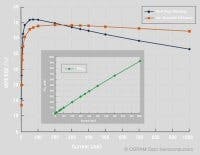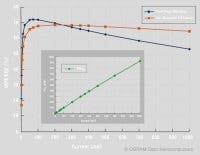The prototype thin-film chip technology achieved a wall-plug efficiency (WPE) of 72% from an operating current of 100 mA. WPE is the ratio of the radiated power to the electrical input power. At higher current levels, the WPE fell, reaching around 54% at 1A (see chart).
The external quantum efficiency (EQE) – the probability that each electron will result in the creation of a photon and its emission from the LED chip – is as high as 67% at 200 mA, and remains above 64% up to an operating current of 1A.
At 850 nm, the wavelength of the chip prototype is useful for infrared illumination, particularly for surveillance tasks and use with CCTV cameras. There are also potential safety applications in the automotive sector, such as pre-crash sensors and illumination sources for night-vision systems.
“The way in which the efficiency and brightness have been increased can be transferred from 850 nm to other wavelengths,” said Markus Bröll, project manager for the development of IRED chips at Osram Opto Semiconductors in Regensburg. “This means that it will be possible to create highly energy-efficient solutions for infrared lighting in the future”. Fewer components will be needed in multi-chip applications, saving both money and energy, he said.
The new chip is expected to go into series production in the first half of 2013.



![An installer uses a cell phone to configure a connected lighting system in a Next Generation Lighting Systems (NGLS) living lab. [Photo credit: Image courtesy of Pacific Northwest National Laboratory (PNNL) and NGLS.] An installer uses a cell phone to configure a connected lighting system in a Next Generation Lighting Systems (NGLS) living lab. [Photo credit: Image courtesy of Pacific Northwest National Laboratory (PNNL) and NGLS.]](https://img.ledsmagazine.com/files/base/ebm/leds/image/2020/06/NGLS_Photo_2.5ed693de53fa2.png?auto=format,compress&fit=crop&q=45&h=139&height=139&w=250&width=250)


